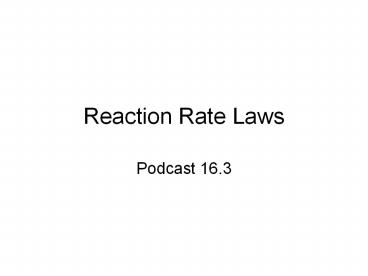Reaction Rate Laws PowerPoint PPT Presentation
1 / 15
Title: Reaction Rate Laws
1
Reaction Rate Laws
- Podcast 16.3
2
16.1-16.2 Review
- Factors affecting reaction rates include
- 1._____________
- 2._____________
- 3._____________
3
Whats a Rate Law?
- A rate law is an expression that relates how the
_______ of reaction changes as ___________________
__ changes.
4
Consider the decomposition of hydrogen
peroxide 2 H2O2 ? 2 H2O O2
- The reaction is _______________
- The rate law is rate k H2O21
- k is called the _________________
- The larger the value for k, the ________ the
reaction. (k is ______________dependent)
H2O2
Initial Rate of Decomp
5
What would a second order reaction look like?
Consider A? B
- The reaction is _______________
- The rate law is rate k A2
A
Initial Rate of Decomp
6
How do we determine the rate law?
- You cannot figure out the rate law from the
balanced equation. - You must look at __________________
- -Alternatively, you can look at graphs or
mechanism, but that will not be covered here. . .
7
Method of Initial Rates
- Allows us to determine reaction order by
comparing initial rates of a reaction carried out
with varying reactant concentrations. - For example if doubling X doubles the rate,
the rate law must be first order with respect to
X. If doubling X quadruples the rate, the rate
law must be second order with respect to X.
8
Example
- Given the following information, determine the
overall rate law for the reaction A
B ? C
Experiment A0 (M) B0 (M) Initial Rate (M/s)
1 1.0 1.0 0.0050
2 2.0 1.0 0.010
3 2.0 2.0 0.040
9
A B ? C
Experiment A0 (M) B0 (M) Initial Rate (M/s)
1 1.0 1.0 0.0050
2 2.0 1.0 0.010
3 2.0 2.0 0.040
- When A doubles, and B is constant, rate
____________ - When B doubles, and A is constant, rate
____________ - The experiment is _____ order with respect to A,
and _____ order with respect to B. - The rate law is _______________________
- Do not compare experiments when both
concentrations change, as they do in experiment 1
and 3.
10
Overall Order
- The overall order is the sum of the exponents in
the rate law. - Rate kA1B2
- represents a _____ order reaction
11
A B ? C
Experiment A0 (M) B0 (M) Initial Rate (M/s)
1 1.0 1.0 0.0050
2 2.0 1.0 0.010
3 2.0 2.0 0.040
- We can also determine the rate constant, k, from
this data, once the rate law is known. - Choose any experiment and substitute values.
12
Practice Problem
- What is the rate law and the value of rate
constant for the reaction 2 AB2 C ? CB BA
based on the data below?
Experiment AB20 (M) C0 (M) Initial Rate (M/s)
1 1.0 1.0 1.4 x 10-7
2 0.5 1.0 3.5 x 10-8
3 1.0 2.0 5.5 x 10-7
13
Solution
14
One last note
- A reaction can also be ________ order.
- This means that the rate does not depend on the
concentration of that reactant. - Mathematically x0 ________
- For a reaction A B ? C that is zero order in
A, and 1st order for B, the rate law would be
15
Chapter 16 -Summary Topics
- Collision Theory
- Average Rate
- Activation Energy
- Catalysis
- Rate Law
- Rate Constant, k
- Reaction Order
- Initial Rates Method
- Not covered - reaction mechanisms/16.4

